Timeless Gladiator Chic: Exploring Spartacus (1960) and Its Iconic Fashion Influence
Fashion history is rife with pivotal moments, where the merging of cinema, design, and cultural zeitgeist creates trends that reverberate through the decades. One such moment is the release of Stanley Kubrick’s epic film, "Spartacus" in 1960. Beyond its cinematic brilliance, Spartacus left an indelible mark on the fashion industry, giving birth to the "Timeless Gladiator Chic" trend. This phenomenon not only showcased the allure of ancient Roman attire but also highlighted the cyclical nature of fashion—how historic influences are perpetually reborn, reinvented, and revered.
Cinematic Influence and Historical Context
"Spartacus" was released during an era marked by a fascination with historical epics. This period, post-World War II, saw an infusion of prosperity and an eagerness to explore narratives that exuded heroism and adventure. This cultural backdrop made the film’s costumes, designed by the Oscar-winning Valles, a significant element of its storytelling. The costume design in Spartacus was instrumental in defining the characters and subtly influencing the fashion sensibilities of contemporary audiences.
The main theme of Gladiator Chic is one of virile elegance, intertwined with a rugged yet refined aesthetic. The film’s costume department drew heavily on historical accuracy while allowing a functional modern twist, paving the way for this fashion trend to filter into popular culture. Tunics, leather armors, and sandals—staples of Roman attire—were interpreted in a way that echoed both antiquity and modern sensibility.
Themes, Styles, and Cultural Influences
The Gladiator Chic look that emerged from Spartacus is characterized by several key elements: simplicity, strength, and sensuality. These themes manifested through essential silhouettes, minimal embellishments, and a focus on the texture and quality of materials. Designers and fashion houses were quick to understand the timeless appeal of these elements. They adopted and adapted them, ultimately creating collections that spoke to the power and allure associated with the ancient warriors and their resilient aesthetic.
The predominant style elements included:
-
Minimalist Silhouettes: The film’s costumes highlighted streamlined silhouettes. Tunics and cloaks, devoid of excessive ornamentation, pointed to a minimalist ethos that resonated with the evolving modern tastes of the 1960s. This simplicity translated into an understated elegance—an aesthetic prized in fashion circles.
-
Rich Materials and Textures: The choice of textiles such as leather, suede, and linen added a rich texture to the costumes of Spartacus. This tactile aspect appealed to designers, offering a canvas for exploring the sensory dimensions of apparel.
- Functional Detailing: The utilitarian yet stylized aspects of Roman armor, including breastplates and studding, allowed for a seamless blend between aesthetics and functionality. This balance is a foundational aspect of successful sartorial design.
Iconic Fashion Moments and Collections
The impact of Spartacus on fashion can be traced through various collections and fashion moments over the decades. The Gladiator Sandal, which saw a revival in the early 2000s, is a direct descendant of this trend. Designers like Valentino and Alexander McQueen have made lasting contributions to the style landscape through their reinterpretations of gladiator-inspired attire.
Valentino’s Spring 2016 collection, for instance, paid homage to ancient Rome with rich, romantic silhouettes, incorporating capes, draped fabrics, and leather elements. The palette bore witness to earth tones—evoking the sandy hues of the Roman Empire—infused with modern elegance.
Alexander McQueen’s collections frequently echo historic themes, and his blending of the romantic with the macabre often touches upon gladiatorial symbolism. His Spring 2003 collection featured elements of armor and warrior-like silhouettes, reimagined in a feminine context, illustrating the timeless appeal of Gladiator Chic.
Cultural, Social, and Historical Reflections
The Gladiator Chic trend reflects broader societal preoccupations with strength, resilience, and individuality—principles embodied in the Spartacus narrative. During the 1960s, there was a burgeoning sense of self-exploration, individual identity, and a breaking away from past conventions; Gladiator Chic, with its inherent defiance and boldness, fit this ethos.
Moreover, the reinterpretation of Roman aesthetics offered a lens through which society could explore and redefine gender roles. The traditionally masculine elements of the Gladiator style were softened and adapted into women’s fashion, contributing to a dialogue on gender fluidity and empowerment—an ongoing conversation in today’s fashion industry.
Legacy and Lasting Influence
The influence of Gladiator Chic persists, with the gladiator sandal and minimalistic, ruggedly elegant designs continuing to appear in contemporary fashion circuits. High fashion and streetwear alike revisit these themes, illustrating the enduring appeal of simplicity braided with power.
This trend has also transcended fashion to permeate popular culture, influencing music video aesthetics, theatrical stage design, and even sporting apparel. As such, Gladiator Chic exemplifies the robust interplay between fashion, media, and societal narratives.
Reflective Questions and Contemporary Relevance
In contemplating the relevance of Gladiator Chic today, several reflective questions arise: How does the enduring appeal of ancient aesthetics inform modern identity? In what ways does the cyclical nature of fashion speak to the human tendency to find continuity and connection through time?
The Timeless Gladiator Chic trend reminds us that in fashion, as in life, history is not merely past but enduring. It invites today’s designers and consumers to draw inspiration from ancient motifs while breathing new life and context into them. As we continue to navigate the complexities of contemporary fashion, the echoes of Spartacus and its lasting influence remain a testament to the power of merging storytelling, history, and style.
Ultimately, as we sift through the annals of fashion history and look forward, these reflections encourage us to consider how we can adapt past influences in ways that reflect our modern ethos, continually reinventing ‘chic’ for a contemporary audience.
Got more questions? Our personalized Fashion Explorer AI assistant is here to help. Click here to start a conversation!
[Advertisement]
Wondering how fashion reflects deeper values? Discover how ANY trend or style relates to positive biblical principles with Fashion and Scripture GPT from BGodInspired.com. Click here to see fashion in a new light!
[Advertisement]

